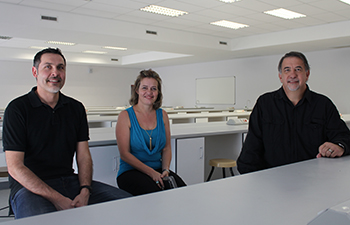
From left are: Dr Cristian Capelli, Associate Professor
of Human Evolution at Oxford University;
Dr Karen Ehlers, Senior Lecturer and Prof Paul Grobler,
both from the Department of Genetics at the UFS.
Photo: Siobhan Canavan
Many people are interested to know more about their history and origins, and with the help of genetics, it is possible to provide more information about one’s roots.
During a lecture at the Department of Genetics at the University of the Free State (UFS), Dr Cristian Capelli, Associate Professor of Human Evolution at Oxford University in the UK, addressed staff members and students on the history of our species.
Reconstructing the history of human population
With his research, titled: People on the move: population structure and gene-flow in Southern Africa, Dr Capelli looks at reconstructing the history of human populations, focusing mainly on how the different human populations are related, as well as how they exchange genes.
He said this research could be of great significance to the medical field too. “Knowing what the genetic make-up of individuals is, can give us some information about their susceptibility to diseases, or how they would react to a given medicine. Therefore, this knowledge can be used to inform health-related policies.”
Combining individual histories of multiple people
To understand this research more clearly, Dr Capelli explained it in terms of DNA and how every individual receives half of their DNA from their mother and half from their father just as their parents had received theirs from their parents. And so it goes from generation after generation. Each individual stores a part of their ancestors’ DNA which makes up the individual genetic history of each person.
“If we combine these individual histories by looking at the DNA of multiple people, we can identify the occurrences that are shared across individuals and therefore reconstruct the history of a population, and in the same way on a larger scale, the history of our own species, homo sapiens.